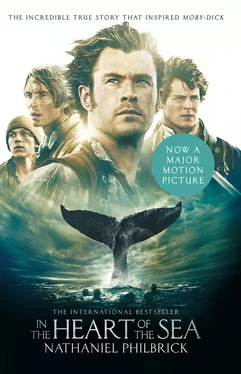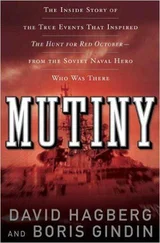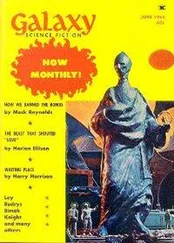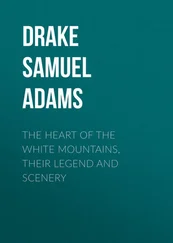The kid was no sooner set down than Captain Pollard came up onto the quarterdeck. Pollard glanced at the tub of beef, and Nickerson watched as his complexion seemed to shift from red, to blue, to almost black. Food was a difficult and sensitive issue for Captain Pollard. As he knew better than anyone, the Essex had been woefully underprovisioned by the parsimonious owners. If there was any hope of providing for the men in the several years ahead, he had to limit their provisions now. He may not have felt good about it, but he had no alternative.
In bringing the kid aft, the men had dared to violate the sacred space of the quarterdeck, normally reserved for the officers. Even if the crew’s anger might be justified, this was a challenge to the ship’s authority that no self-respecting captain could tolerate. It was a critical moment for a commander who desperately needed to shake his crew out of a corrosive and potentially disastrous malaise.
Casting aside his normal reticence, Pollard roared out, “Who brought this kid aft? Come here, you damned scoundrels, and tell me!”
No one dared speak. The men sheepishly made their way toward the quarterdeck as a group, each trying to hide himself behind the others. It was just the display of timidity this first-time captain needed.
Pollard paced the quarterdeck in a fury, working a quid of tobacco in his mouth and spitting on the deck, all the while muttering, “You’ll throw your kid in my face, you damned scoundrels, will you?”
Finally, he made his way to the forward part of the quarterdeck, pulled off his jacket and hat, and stamped on them. “You scoundrels,” he snarled, “have not I given you all the ship could afford? Have not I treated you like men? Have you had plenty to eat and drink? What in hell do you want more? Do you wish me to coax you to eat? Or shall I chew your food for you?”
The men stood there dumbfounded. Pollard’s eyes strayed up into the rigging where Nickerson sat with his tar brush. Pointing a finger at him, the captain bellowed, “Come down here, you young rascal. I’ll kill the whole bunch of you together and then bang up northwest and go home.”
Not having any idea what the captain meant by “banging up northwest,” Nickerson slunk down to the deck, fully expecting to be, if not killed, at least flogged. But much to everyone’s relief, Pollard dismissed all hands, saying, “If I hear any more from you about provisions, I’ll tie the whole of you up together and whip it out of you.”
As the crew dispersed, Pollard could be heard growling what became known among the men as his “soliloquy,” which they parodied in a bit of doggerel that Nickerson still remembered fifty-seven years later:
Thirty hogs in the Isle of May
Duff every other day
Butter and cheese as much as you could sway
And now you want more beef, damn you.
Pollard’s behavior was fairly typical of Nantucket whaling captains, who were famous for oscillating wildly between tight-lipped reserve and incandescent rage. Pollard was, according to Nickerson, “generally very kind where he could be so…[This] display of violence was only one of his freaks and passed off with the setting sun. The next morning found him as kind as before.”
Yet everything aboard the Essex had changed. Captain Pollard had proved he had the backbone to put the men in their place. From that day forward, no one ever complained about provisions.
CHAPTER FOUR
The Lees of Fire
AT EIGHT IN THE MORNING on November 25, 1819, the lookout cried, “Land ho!” In the distance, what appeared to be an island of rock towered high above the water. Without hesitation, Captain Pollard pronounced it to be Staten Island, off the eastern tip of Cape Horn. The crew was staring at this legendary sphinxlike sight when suddenly it dissolved in the hazy air. It had been nothing but a fog bank.
The dangers of the Horn were proverbial. In 1788 Captain William Bligh and the crew of the Bounty had attempted to round this menacing promontory. After a solid month of sleet-filled headwinds and horrendous seas that threatened to break up the ship, Bligh decided that the only sensible way to reach the Pacific was to go the other way, so he turned the Bounty around and headed for Africa’s Cape of Good Hope. Twenty-five years later, during the War of 1812, a much larger vessel, also named the Essex , an American naval frigate commanded by Captain David Porter, rounded the Horn. Porter and his men would eventually become famous for their heroics against a superior British force in the Pacific, but Cape Horn put a fright into the otherwise fearless mariner. “[O]ur sufferings (short as has been our passage) have been so great that I would advise those bound into the Pacific, never to attempt the passage of Cape Horn, if they can get there by another route.”
The whalemen of Nantucket had a different attitude toward the Horn. They’d been rounding it regularly ever since 1791, when Captain Paul Worth steered the Beaver , a whaleship about the size of the Essex , into the Pacific. Pollard and Chase had done it at least three times; for Pollard it may have been his fourth or even fifth time. Still, Cape Horn was nothing any captain took for granted, certainly not one who, like Pollard, had almost lost his ship in the relatively benign Gulf Stream.
Soon after watching the mirage island vanish before them, the men of the Essex saw something so terrible that they could only hope their eyes were deceiving them once again. But it was all too real: from the southwest a line of ink-black clouds was hurtling in their direction. In an instant the squall slammed into the ship with the force of a cannon shot. In the shrieking darkness, the crew labored to shorten sail. Under a close-reefed maintopsail and storm staysails, the Essex performed surprisingly well in the mountainous seas. “[T]he ship rode over them as buoyantly as a seagull,” Nickerson claimed, “without taking onboard one bucket of water.”
But now, with the wind out of the southwest, there was the danger of being driven against the jagged rocks of the Horn. The days became weeks as the ship struggled against the wind and waves in nearfreezing temperatures. In these high latitudes the light never entirely left the night sky. Without the usual sequence of light and dark, the passage stretched into a dreary, seemingly unending test of a whaleman’s sanity.
It took more than a month for the Essex to round Cape Horn. Not until January of the new year, 1820, did the lookout sight the island of St. Mary’s, a gathering spot for whalers off the coast of Chile. To the south of the island in the bay of Arauco they found several Nantucket vessels, including the Chili , the same ship with which they had left the island five months earlier.
The news from the west coast of South America was not good. For one thing, the political situation in Chile and Peru was extremely volatile. In recent years towns up and down the coast had been ravaged by fighting between the Patriots, who hoped to wrest control of South America from Spain, and the Royalists, whose interests were still linked to the mother country. Although the Patriot forces, assisted by the swashbuckling British naval hero Lord Cochrane, appeared in the ascendancy, fighting was still going on, particularly in Peru. Caution was the watchword when provisioning on this coast.
For most vessels it had been a miserable whaling season. While the scarcity of whales kept up the price of oil back home on Nantucket, these were tough times for whalemen in the Pacific. After driving his crew to fill his ship, the Independence , Captain George Swain had returned to Nantucket in November and predicted, “No other ship will ever fill with sperm oil in the South Seas.” Obed Macy feared Captain Swain might be right: “Some new place must be found where the whales are more numerous,” he told his journal, “or the business will not be worth pursuing.” Praying that they might elude these grim forecasts, the crew of the Essex headed out to sea.
Читать дальше












